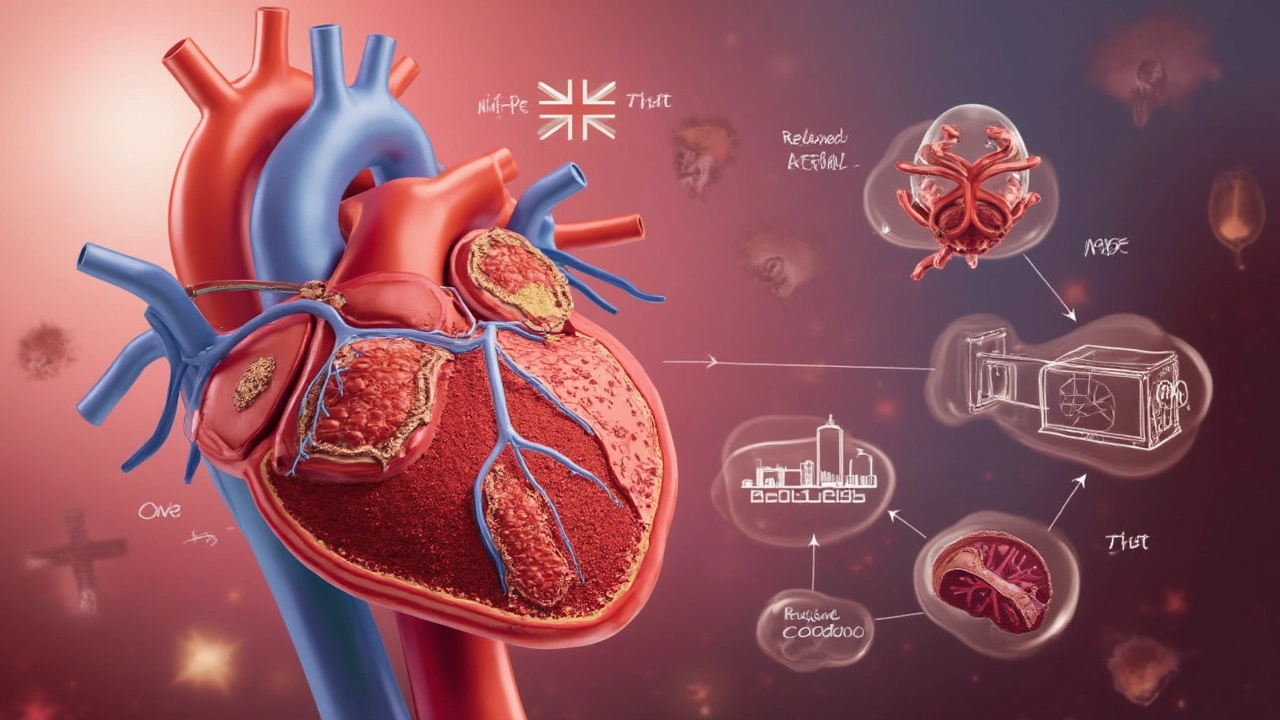Procardia: Complete Guide to Nifedipine for Blood Pressure & Heart Health
 Jun, 18 2025
Jun, 18 2025
Everyone knows someone whose life quietly depends on a pill. Sometimes, it’s just a part of the morning routine. Other times, it’s the single line between normalcy and a wild ride no one signed up for. That’s especially true with blood pressure meds, and Procardia—better known in pharmacies as nifedipine—ranks high on the list of those little lifelines. But what’s invisible behind that orange bottle? There’s a lot more to Procardia than its name on a prescription. Let’s pull back the curtain and unravel why this drug matters so much for millions of people who simply want steady, reliable heartbeats.
What is Procardia and Why is it So Widely Used?
Imagine a tiny tablet with the power to help you dodge strokes and heart attacks. That’s Procardia in a nutshell. The generic name is nifedipine, and it belongs to the class of calcium channel blockers—medicines tailor-made to relax the blood vessels so blood can flow easier. No fanfare, just science making life safer. Originally, Procardia made a splash in the late 1970s when doctors started prescribing it for angina (chest pain due to clogged heart arteries). By relaxing and widening the blood vessels, it sends more oxygen to the hardworking heart muscle.
These days, nifedipine’s on most doctors’ radars because of how well it tames high blood pressure. According to the CDC, about 1 in 3 adults in the US deals with high blood pressure. That’s millions relying on meds like Procardia to stay in the safe zone. It’s also called upon for other jobs: easing a dangerously tight esophagus in some conditions, or, surprisingly, stopping early labor by relaxing the uterus.
This versatility is why nifedipine’s still getting refills decades after its debut. It comes in several forms—quick-release capsules if you need help right now, and extended-release tablets for steady, around-the-clock protection. Doctors often reach for Procardia when other first-line meds don’t cut it or side effects become a problem. It’s equally at home in emergency rooms during hypertensive crises and in daily medicine cabinets for at-home management.
What’s not so obvious until you live it? Nifedipine is usually well-tolerated. People aren’t lining up to swap stories about it at parties, because most just get on with life—it works quietly, like a backstage tech making sure the show doesn’t go off the rails. Still, like every heart medication, it’s not a one-size-fits-all tool. Your doctor will weigh your medical history, other meds, and current health before putting this little tablet in your daily lineup.
How Does Procardia Actually Work in the Body?
Picture your arteries as highways, sometimes jammed, sometimes free. Blood pressure spikes when these “roads” tighten up, making each heartbeat feel like a labor. Procardia gets to work as a fixer—it blocks calcium from entering the muscle cells lining those arteries, and calcium is what makes these muscles squeeze tight. Less calcium means those walls relax, and suddenly, more cars (your blood) sail through without bumper-to-bumper traffic.
This relaxing effect isn’t just calming for blood pressure. It can help prevent heart attacks, because reduced pressure means the heart isn’t under as much stress. Studies show that patients with untreated high blood pressure are at least twice as likely to have a heart attack compared to those who manage it with medication. Nifedipine widens those bottlenecks, and by extension, your heart can pump away with less resistance.
But there’s another bonus—Procardia limits angina (chest pain) by making sure oxygen-packed blood reaches heart muscles starving for it. If arteries open wider, oxygen delivery improves, leaving less chance for that unmistakable crushing pressure folks with angina know all too well.
Besides keeping arteries supple and spasm-free, nifedipine shifts the load from your heart to your medicine. Instead of your heart muscle straining to force blood through a straw, Procardia makes every beat count with less effort. It’s a win for anyone with bad family histories or early warning signs flashing at annual physicals.

Who Should Take Procardia—and Who Shouldn’t?
Doctors prescribe Procardia if you have consistently high blood pressure, chronic angina, or sometimes for off-label surprises like Raynaud’s phenomenon (where fingers turn white and blue from cold). People with hypertensive emergencies—a sudden, dangerous spike in blood pressure—often get quick-acting forms in the ER. It’s also a go-to option when certain beta blockers or ACE inhibitors can’t be used for one reason or another.
Here’s the thing: not everyone’s system plays nice with nifedipine. Folks with very low blood pressure, or a history of aortic stenosis (a tight heart valve), need something different. Sometimes, the drug can cause swelling in the feet or headaches—side effects that might be more than just a nuisance for some. Pregnant women might hear about Procardia if labor threatens to start too early, but the call is always made by maternity specialists for the safest possible outcome.
If you’re on medications that also lower blood pressure—like diuretics, other calcium blockers, or even some antidepressants—make sure your doctor knows every single prescription and supplement. Mixing the wrong meds can send your blood pressure dropping through the floor, which is as risky as letting it soar.
This chart breaks down who typically benefits, and who should steer clear, based on real patient cases and common prescribing practices.
| Can Take Procardia | Should Avoid Procardia |
|---|---|
| High blood pressure (uncontrolled) | Severe low blood pressure (hypotension) |
| Chronic stable angina | Severe aortic stenosis |
| Raynaud’s phenomenon | History of hypersensitivity to nifedipine |
| Preterm labor (with careful supervision) | Recent heart attack (caution needed) |
Don’t switch to or from Procardia without checking with your doctor. Stopping abruptly can spike your blood pressure and lead to chest pain or even a heart attack, so the hand-off should always happen under medical supervision.
How to Take Procardia Safely: Dosage, Timing, and Daily Tips
This isn’t one of those “grab it on an empty stomach, whenever you feel like it” kind of meds. Procardia’s timing matters. Most people take the extended-release form once daily, around the same time each day, usually with a light meal or snack. Quick-release capsules, used less often now, are sometimes dosed two or three times a day for emergencies, but not for routine high blood pressure—doctors moved away from this because blood pressure can swing too wildly if not closely monitored.
- Swallow the tablet whole—don’t crush or chew it. Breaking it up interferes with its slow-release design, dumping medicine too fast and risking side effects.
- If you miss a dose, skip it and go back to your usual schedule. Doubling up “just in case” is a fast track to dizziness or lightheadedness.
- Be mindful what else is in your system. Grapefruit and grapefruit juice can stomp on the enzyme that breaks down nifedipine, making levels skyrocket. If you crave citrus, stick to oranges.
- If you drink alcohol, know it can make side effects (like dizziness or flushing) worse, especially early on when you’re figuring out your body’s reaction.
Folks often wonder if they’ll feel “different” on this medication. The truth? Maybe. Nifedipine sometimes causes headaches, swelling in feet or ankles, flushing, or an odd sensation of a fast pulse. Usually these mild symptoms pass after a week or two, as your system adapts. If symptoms feel extreme or show up out of nowhere after being stable, let your doctor know. Rare side effects like chest pain, severe dizziness, or a rapid heartbeat deserve quick attention—don’t try to tough it out.
Routine matters with heart meds. Setting alarms, using pill organizers, and linking the dose to a daily ritual (like breakfast or brushing your teeth) can turn pill-taking from a chore into a habit. That’s critical, because missing doses causes your blood pressure to spike and surge—raising your risk for stroke or heart attack.
Here’s a common dosing schedule for extended-release Procardia:
| Time of Day | Dosage |
|---|---|
| Morning | 30-60mg (once daily, adjusted by doctor) |
Never mess with your dose on your own. If your blood pressure numbers are stubborn or you notice weird side effects, check in with your provider. They can tweak your meds without risking dangerous swings in your numbers.

What to Watch For: Side Effects, Interactions, and When to Call for Help
No one likes surprises from their medication cabinet. Procardia (nifedipine) generally plays nice, but a few classic side effects do pop up. The most common are swelling (edema) in the lower legs and ankles, headaches, dizziness when standing, flushing, and a fast or pounding heartbeat. Most folks get hit with these in the first couple of weeks—think of it as your system sorting out its “new normal.”
If side effects stick around or mess with your daily life, bring it up with your doctor—not Dr. Google. Sometimes, adjusting the dose or switching to another calcium channel blocker with fewer side effects is the easiest fix. Less often, people notice gum swelling or mild constipation. Brushing and flossing regularly helps keep gum overgrowth at bay, and bumping up fiber and water counters sluggish bowels.
The list of things to be careful with isn’t long, but it matters. Grapefruit, as mentioned, can ramp up nifedipine levels and boost side effects, so ditch it. Some antibiotics, antifungals, and even drugs for HIV can do the same. Make sure every healthcare pro you see—specialists, pharmacists, dentists—knows you’re taking Procardia. Open communication helps catch those hidden interactions before they cause trouble.
Most important: if you get chest pain, severe shortness of breath, fainting, or rapid, irregular heartbeats, call your doctor or seek help. Sometimes these are signs your blood pressure dropped too low, or your heart’s not handling the new med. These incidents are rare but always worth airing on the safe side.
Here’s a table with side effects and how often they’re reported, based on FDA monitoring and real patient feedback:
| Side Effect | Approximate Frequency |
|---|---|
| Swelling in legs/ankles | 10-20% |
| Headache | 8-12% |
| Flushing | 5-8% |
| Dizziness | 4-7% |
| Constipation | 1-4% |
Big takeaway? Most people can live their normal lives on Procardia, watch for warning signs, and lean on their healthcare team when in doubt. You don’t have to be a pharmacist to manage it—just stay observant and don’t brush off changes that “feel off.”

Shaik Basha
July 18, 2025 AT 13:51Wow, this guide on Procardia is pretty dope! Nifedipine really seems like a game-changer for people struggling with blood pressure issues. I like how they break down the uses and side effects clearly – makes it way less intimidating to understand.
Has anyone tried managing their daily routine while on Procardia? I feel like balancing meds with lifestyle changes can sometimes be a pain. Also, those tips on heart health support – super useful stuff!
Would be great to hear real stories from those taking it long-term. Feels like this guide pulls all the important bits together without making it boring. Very cool, thanks for sharing!
Olivia Crowe
July 21, 2025 AT 21:51Oh my gosh, this is such an encouraging read! Managing blood pressure can often feel so overwhelming, but seeing such a comprehensive guide really lifts my spirits. It’s like a roadmap for heart health with a safety net.
The daily management tips especially hit home. Sometimes, it’s the small consistent changes that make the biggest difference, right? I love that it emphasizes understanding the side effects too—it’s better to be informed than scared.
Anyone else feel more motivated to take control of their health after reading something like this?
Sen Đá
July 22, 2025 AT 09:31While I appreciate the effort to elucidate about Procardia, I find the content somewhat lacking in depth regarding contraindications and drug interactions. It is imperative for such articles to maintain a tone of thoroughness and precision since patient safety is paramount.
Moreover, there should have been clearer instructions about when to seek medical consultation, especially given the possible severe side effects of nifedipine. A medical guide that misses these critical components risks misleading readers.
Has anyone encountered any significant negative outcomes due to inadequate information in such resources?
We must advocate for better and more responsible health communication.
Michael Ieradi
July 25, 2025 AT 03:38This is a decent overview; however, the explanation of the mechanism of action of nifedipine could have been spelled out in a simpler manner. Some of us might not be medically inclined, and breaking down how it exactly lowers blood pressure would improve understanding significantly.
Also, a practical guide on what to do if a dose is missed would be a welcome addition.
Nevertheless, it’s great to see an article dedicated to this common heart medication’s role. I think more patient-centric details would make it stand out even more.
Stephanie Zuidervliet
July 27, 2025 AT 17:18Can we talk about how side effects sometimes seem way scarier than necessary? Like, sure, there are risks, but this post actually did a solid job balancing the good and the bad. I’m so tired of posts that just freak you out with side effects and drown out the benefits.
The daily tips were a nice touch! Honestly, it’s those small life hacks that stick with me and help make managing health less of a drag.
Still, I wish there were some real user testimonials—it would spice things up and make it feel less like a dry manual!
Aayush Shastri
July 30, 2025 AT 09:44I am impressed by how this article respects cultural differences while discussing daily management tips. For example, dietary guidance is more universal yet can be adapted to various cuisines, which is often overlooked in heart health advice.
Furthermore, emphasizing the importance of regular follow-ups with healthcare professionals aligns well with the best practice standards observed in many cultures.
One suggestion might be expanding on how stress management techniques could complement Procardia therapy, particularly considering differing cultural approaches to mental wellness.
Quinn S.
August 2, 2025 AT 05:14This post is a commendable attempt, albeit it falls short of clinical rigor. The terminology used lacks consistency, and critical references to peer-reviewed studies supporting the claims made are wholly absent. For a guide purported to be 'complete,' depth and scientific backing are non-negotiable.
Additionally, the side effects section seems underdeveloped. Adverse events should be categorized by severity and frequency, with corresponding recommendations clearly delineated.
One cannot overstate the necessity of precision and evidence in medical communications; otherwise, misinformation could be propagated.
Dilip Parmanand
August 4, 2025 AT 23:04Hey guys, just chiming in to say I found this article pretty motivating. It’s nice when you don’t get lost in jargon and you get real tips that actually make sense in everyday life.
Like the sections on daily management — those little nuggets make a difference in sticking with treatments. Anyone else find it easier to stay on track with a straightforward guide like this?
Would love to hear from others who've integrated Procardia successfully. Sharing wins always pumps me up!
Sarah Seddon
August 9, 2025 AT 10:51Wow, what an enlightening read! This guide beautifully combines science and practicality with a vibrancy that is truly inspiring. Procardia, often clouded by myths, is presented here with clarity and empathy.
The daily management tips feel like a warm hug, gently nudging you towards healthier habits without overwhelming. I adore how it encapsulates the essence of heart care beyond just medication.
Would anyone care to share how this has personally impacted their journey? Stories always create a soulful connection.
Miriam Bresticker
August 12, 2025 AT 06:04OMG, u guys, this post got me thinking 🤔💭 about how meds like Procardia are more than just pills 💊; they are a part of a person's soul and rhythm 🌀💓
Sometimes, side effects might be like little waves 🌊 in an ocean of healing, but knowing the benefits helps us ride them better 🏄♂️✨.
I wonder if anyone's mixed it with herbal stuff? Anyone? Share plz 🙏😊
Claire Willett
August 15, 2025 AT 12:58From an evidence-based perspective, this guide on nifedipine encapsulates essential pharmacodynamics and practical cues concisely. Yet, it could benefit from integrating more peer-reviewed data and clinical trial insights to substantiate claims.
Nonetheless, the pathway outlined for daily management is pragmatic and supportive of medication adherence, a crucial component often neglected.
Overall, a good resource, particularly for new patients seeking jargon-light but informative content.